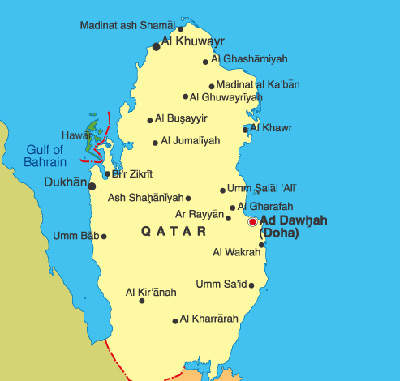
Following the successful opening of the first phase of the Oryx gas-to-liquids facility in June 2006 Qatar Petroleum launched its new GTL project ‘Pearl’ in July 2006. The project is jointly owned by Qatar Petroleum and Royal Dutch Shell and includes the development of two offshore natural gas resources in the Qatar North Field.
The Pearl GTL project also includes transporting and processing the gas to extract natural gas liquids and ethane, and the conversion of the remaining gas into liquid hydrocarbon products through the construction of a new fully integrated GTL complex in Ras Laffan Industrial City situated 80km north of Doha.
The offshore platforms are connected to the plant through a 60km pipeline.
Construction of the plant began in February 2007. The first sour gas began to flow into the plant in March 2011.
When fully operational, the Pearl GTL project will have a capacity to produce 140,000bpd of GTL products and 120,000bpd oil equivalent of LPG, condensate and ethane.
Over its lifetime the integrated project will produce upstream resources of approximately three billion barrels of oil equivalent.
Technology and investment in Pearl GTL
The Pearl GTL project is based on Shell’s proprietary GTL technology, which has been used for more than ten years following the first commercial GTL plant of its type in Bintulu, Malaysia.
The GTL project, which began the planning process in July 2004, was developed under a development and production sharing agreement with the Government of the State of Qatar.
The agreement covers offshore and onshore costs, with Shell providing 100% of the project’s funding, which is estimated to be between $18bn and $19bn.
Production from the first Pearl GTL train (phase I) began in March 2011. Start-up of the second train is expected to follow by 2012 (phase II). The plant uses Shell’s proprietary Shell Middle Distillates Synthesis (SMDS) technology. The facilities are operated by Qatar Shell GTL, a Shell subsidiary.
Contractors for the Pearl GTL project
JGC Corporation of Japan and Kellogg Brown and Root (KBR) were awarded the project management contract for the project in mid-2005. In addition to the development of offshore upstream gas production facilities, the project comprises the development of the onshore GTL plant.
The JGC / KBR joint venture completed the basis of design / basis design package and the subsequent front end engineering design in late 2004. The JGC / KBR role included project management and start-up support of the overall onshore Pearl GTL complex, along with engineering, procurement and construction management of the GTL synthesis, utilities and infrastructure sections of the complex.
In June 2005, Honeywell was awarded a contract to provide front-end engineering design for the automation and control systems. Honeywell’s work included process automation and control including asset management and fieldbus solutions, safety, fire and gas, and the specification for a multi-purpose dynamic simulator to be used for dynamic studies, engineering verifications and operator training.
Honeywell, in consultation with Shell, developed the Shell Engineering Toolkit to meet the tender requirements. Honeywell provided the solutions that meet the standards of instrumentation engineering solutions powered by INtools. In August 2006, the Hyundai Engineering & Construction and Toyo Engineering consortium won the engineering, procurement and construction contract for the liquid processing unit. In September 2006 General Electric won the contract to supply six gas turbines, equipped with dual fuel Integrated Gasification Combined Cycle combustion systems.
In addition to the 42MW gas turbine-generators, the scope of the contract included IGCC combustion engineering, combustion system lab testing, spare parts and training. The gas turbines are installed in the Pearl GTL plant in a cogeneration configuration to produce 180MW of power for use in the facility.
In July 2008, Cannonway Consultants were contracted to provide commercial, contractual and quantity surveying services for the GTL plant. In January 2011, Qatar Shell GTL awarded the framework agreement to Kentz Corporation for providing plant change request execution services for three years.
Pearl operations
At the upstream end of the operation 1.6 billion cubic feet per day of wellhead gas will be produced from the North Field and transported and processed to produce approximately 120,000 barrels of oil equivalent per day of condensate, liquefied petroleum gas and ethane.
At the downstream end dry gas is used as feedstock for a new onshore integrated GTL complex, which will manufacture an additional 140,000bpd of liquid hydrocarbon products.
The Pearl GTL complex will consist of two 70,000bpd GTL trains and associated facilities. The plant will produce a range of clean liquid products and fuels, comprising naphtha, GTL fuel, normal paraffins, kerosene and lubricant-based oils.
GTL fuel is the largest component of the product slate and is suitable for use in existing light- and heavy-duty diesel engines. It also has lower emissions at the point of use, which makes it important as a low sulphur fuel in Europe and the US (both introduced more stringent emissions policies in 2005).
Qatar’s GTL ambitions
Qatar aims to become the leading exporter of LNG in the world by 2012, by which time the country’s annual gas production will reach 77 million tonnes. Qatar’s oil production will also increase from 800,000bpd to one million bpd by the end of 2011.
Qatar is committed to investing over $130bn in oil and gas infrastructure projects to increase its annual production to 18 million tonnes by 2016.
The Pearl GTL project will accelerate the strategy of diversifying natural gas usage and will serve to promote Qatar’s ambition of being the GTL capital of the world.

